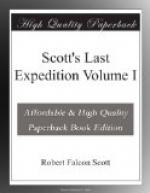Evans and Crean are repairing sleeping-bags, covering felt boots, and generally working on sledging kit. In fact there is no one idle, and no one who has the least prospect of idleness.
Saturday, May 6.—Two more days of calm, interrupted with occasional gusts.
Yesterday, Friday evening, Taylor gave an introductory lecture on his remarkably fascinating subject—modern physiography.
These modern physiographers set out to explain the forms of land erosion on broad common-sense lines, heedless of geological support. They must, in consequence, have their special language. River courses, they say, are not temporary—in the main they are archaic. In conjunction with land elevations they have worked through geographical cycles, perhaps many. In each geographical cycle they have advanced from infantile V-shaped forms; the courses broaden and deepen, the bank slopes reduce in angle as maturer stages are reached until the level of sea surface is more and more nearly approximated. In senile stages the river is a broad sluggish stream flowing over a plain with little inequality of level. The cycle has formed a Peneplain. Subsequently, with fresh elevation, a new cycle is commenced. So much for the simple case, but in fact nearly all cases are modified by unequal elevations due to landslips, by variation in hardness of rock, &c. Hence modification in positions of river courses and the fact of different parts of a single river being in different stages of cycle.
Taylor illustrated his explanations with examples: The Red River, Canada—Plain flat though elevated, water lies in pools, river flows in ‘V’ ‘infantile’ form.
The Rhine Valley—The gorgeous scenery from Mainz down due to infantile form in recently elevated region.
The Russian Plains—Examples of ‘senility.’
Greater complexity in the Blue Mountains—these are undoubted earth folds; the Nepean River flows through an offshoot of a fold, the valley being made as the fold was elevated—curious valleys made by erosion of hard rock overlying soft.
River piracy—Domestic, the short circuiting of a meander, such as at Coo in the Ardennes; Foreign, such as Shoalhaven River, Australia—stream has captured river.
Landslips have caused the isolation of Lake George and altered the watershed of the whole country to the south.
Later on Taylor will deal with the effects of ice and lead us to the formation of the scenery of our own region, and so we shall have much to discuss.
Sunday, May 7.—Daylight now is very short. One wonders why the Hut Point party does not come. Bowers and Cherry-Garrard have set up a thermometer screen containing maximum thermometers and thermographs on the sea floe about 3/4’ N.W. of the hut. Another smaller one is to go on top of the Ramp. They took the screen out on one of Day’s bicycle wheel carriages and found it ran very easily over the salty ice where the sledges give so much trouble. This vehicle is not easily turned, but may be very useful before there is much snowfall.




